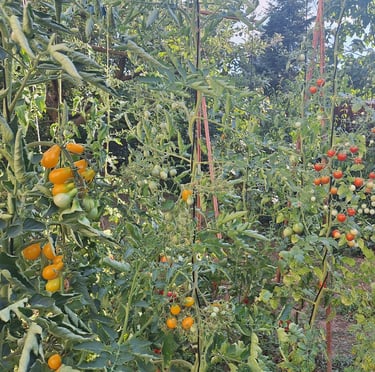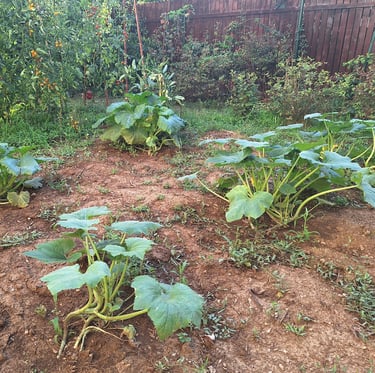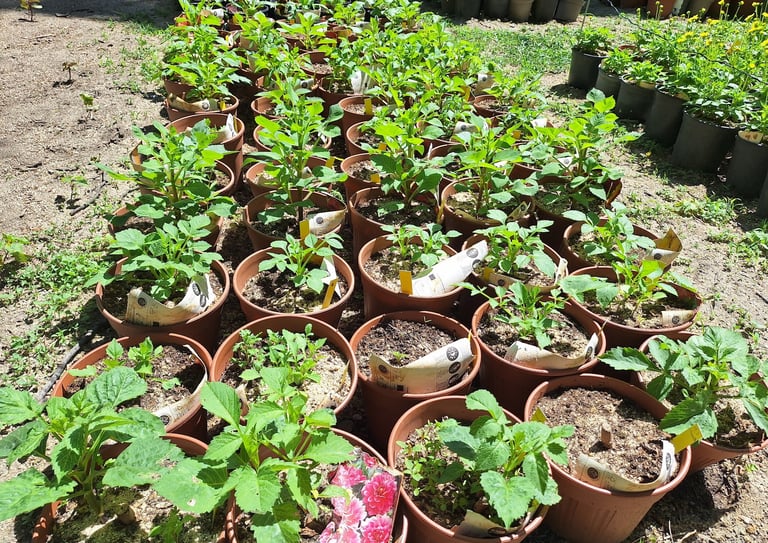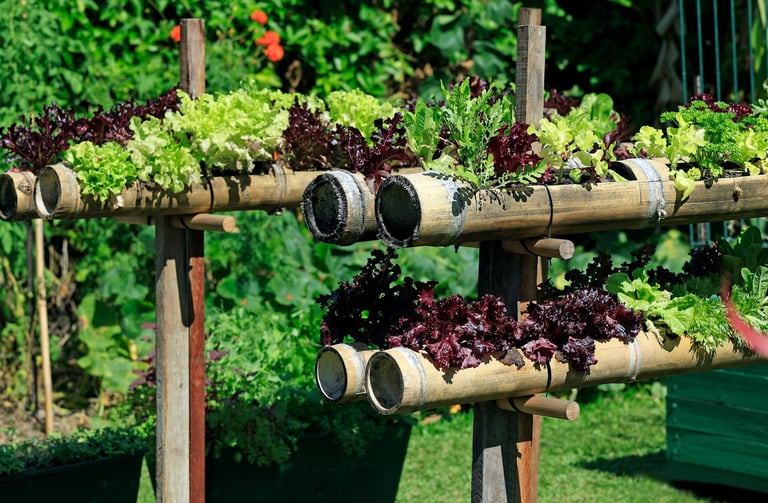3 Simple Types of Vergetable Gardening Methods
Whether you’re a seasoned gardener or just starting out, in our experience even choosing the right gardening method is crucial for success.
In this article, we’ll explore 3 types of vegetable gardening.
Each method has its unique advantages, and we'll provide step-by-step guides to help you get started.








Important Key Takeaways of the 3 Vegetable Gardening Methods
In-ground gardens are great for beginners with space.
Container gardens suit limited areas, offering flexibility.
Vertical gardening is great for limited space but small yields.
1. Traditional In-Ground Gardening
Traditional in-ground gardening is the most common and time-tested method of growing vegetables.
It involves planting directly into the soil, making use of the natural ground as your garden bed. This method is ideal for those with sufficient space and suitable soil conditions as well as the right plants for containers.
Why Is Traditional In-Ground Gardening a Great Method?
We experienced that in-ground gardening is ideal for those who have plenty of space and a desire to grow larger quantities of vegetables.
This method allows for deep root growth and is particularly effective in areas with fertile, well-draining soil.
After preparing the soil properly, we saw that plants thrive, and yields can be abundant.
Step-by-Step Guide to Traditional In-Ground Gardening
Choose the Right Location
Begin by selecting a sunny spot in your garden that receives at least 6-8 hours of sunlight daily. Vegetables require plenty of light to grow strong and healthy.Prepare the Soil
Test your soil to determine its pH level and nutrient content. Amend the soil with organic matter such as compost or aged manure to improve its fertility and structure. If the soil is too clayey or sandy, adding compost can enhance its texture.Design Your Garden Layout
Plan your garden layout by deciding where each vegetable will be planted. Consider crop rotation, companion planting, and the space each plant needs to grow.Plant Your Vegetables
Sow seeds or transplant seedlings into the prepared soil. Follow the recommended planting depth and spacing for each type of vegetable. Water your plants thoroughly after planting.Mulch and Water
Apply a layer of mulch around your plants to retain moisture, suppress weeds, and regulate soil temperature. Water the garden regularly, especially during dry periods, ensuring the soil remains consistently moist but not waterlogged.Maintain Your Garden
Regularly check for pests and diseases, and take action as needed. Weeding, fertilizing, and providing support for climbing plants are also essential tasks to keep your garden healthy and productive.


2. Container Gardening
Container gardening is a versatile method that allows you to grow vegetables in pots or other containers, making it perfect for small spaces like balconies, patios, or rooftops.
This method is ideal for those with limited space or poor soil quality.
Why Choose Container Gardening as One of Your 3 Types of Gardening?
We discovered that container gardening offers incredible flexibility, allowing you to grow vegetables in virtually any location, regardless of soil quality or space constraints.
After experimenting with various containers, we saw that using large pots or containers with good drainage results in healthier plants and better yields.
Step-by-Step Guide to Container Gardening
Choose the Right Containers
Select containers that are large enough to accommodate the root systems of your chosen vegetables. Ensure the containers have drainage holes to prevent waterlogging. We recommend using containers that are at least 12 inches deep for most vegetables.Select a Potting Mix
Fill your containers with a high-quality potting mix specifically designed for container gardening. This mix should be light, well-draining, and rich in organic matter to support healthy plant growth.Decide on the Vegetables
Choose vegetables that are well-suited to container growing, such as tomatoes, peppers, lettuce, or herbs. Consider the size of the mature plant and the space available in the container.Plant Your Vegetables
Plant seeds or seedlings in the container, following the recommended depth and spacing for each type. Containers can dry out quickly, so water the plants immediately after planting and ensure they receive enough water regularly.Position the Containers
Place your containers in a location that receives adequate sunlight for the specific vegetables you’re growing. Most vegetables require at least 6-8 hours of sunlight daily.Water and Fertilize
Water your container plants regularly, ensuring the soil remains consistently moist but not waterlogged. Since container soil can lose nutrients more quickly, apply a balanced liquid fertilizer every few weeks to support healthy growth.Maintain Your Container Garden
Regularly check for pests, diseases, and signs of nutrient deficiencies. Pruning, deadheading, and harvesting are essential tasks to keep your container garden productive and healthy. We observed that container plants often require more frequent watering and fertilizing than in-ground or raised bed gardens, but the results can be just as rewarding.











3. Vertical Gardening
Vertical gardening is a method that utilizes vertical space to grow vegetables, making it an excellent option for gardeners with limited ground space.
By training plants to grow upwards rather than outwards, you can grow more in less space and create a unique and visually appealing garden.
Why Choose Vertical Gardening?
We experienced that vertical gardening is a game-changer for small spaces or urban settings.
After setting up a vertical garden, we saw that it not only saves ground space but also makes harvesting easier, as the plants are at eye level.
Vertical gardening can also reduce the risk of pests and diseases since the plants are off the ground.
Step-by-Step Guide to Vertical Gardening
Select a Location: Choose a sunny wall, fence, or trellis where you can anchor your vertical structures. Ensure the location receives at least 6-8 hours of sunlight daily.
Choose the Right Structures: Install vertical supports such as trellises, stakes, or hanging systems with hanging plants in shade or sun. We found that sturdy trellises work best for heavier plants like tomatoes and cucumbers, while hanging pots are ideal for herbs and small vegetables.
Select Suitable Vegetables: Choose vegetables that naturally grow upwards or can be trained to climb like tomatoes. Vining plants like beans, peas, cucumbers, and tomatoes are excellent choices. Leafy greens and herbs also work well in hanging baskets or tiered systems.
Plant Your Vegetables: Plant seeds or seedlings at the base of your vertical structures, ensuring that climbing plants are properly supported. For hanging systems, plant your vegetables in pots or containers that can be attached to the vertical structure.
Guide the Plants: As the plants grow, guide their vines or stems to climb the supports. We recommend tying the plants gently to the trellis or structure to encourage upward growth. Regularly check and adjust as needed.
Water and Fertilize: Vertical gardens may dry out more quickly, so ensure regular watering. Water from the top, allowing it to trickle down through the plants. Fertilize as needed, particularly for plants in containers, to maintain nutrient levels.
Maintain the Vertical Garden: Regularly prune the plants to remove dead or yellowing leaves and ensure good air circulation. We observed that vertical gardens tend to have fewer pest issues, but it’s still important to monitor for signs of trouble.






5 Expert Tips for Implementing the 3 Vegetable Gardening Methods
Start with Soil Preparation: For in-ground gardens, ensure your soil is well-drained and rich in organic matter. Amend with compost or manure for optimal plant growth.
Choose the Right Containers: When using container gardening, select containers with proper drainage holes. The larger the container, the better it will support root growth and plant stability.
Build Strong Raised Beds: Construct raised beds from durable materials like cedar or treated wood, and fill them with a quality soil mix that promotes healthy vegetable growth.
Consider Plant Spacing: Whether planting in-ground, in containers, or in raised beds, be mindful of spacing to allow for proper air circulation and root development.
Water Wisely: Implement a consistent watering schedule, ensuring that in-ground gardens receive deep watering, containers are watered more frequently, and raised beds retain moisture with mulch.
FAQs
What are the three types of gardens?
The three main types of gardens include in-ground gardens, container gardens, and vertical gardens. Each offers unique benefits depending on your space, soil quality, and gardening experience.
What are the three main types of vegetables?
The three main types of vegetables are leafy greens, root vegetables, and fruit-bearing vegetables. These categories help in understanding their growing needs and best gardening practices as well as companion planting.
How many types of vegetable gardens are there?
There are several types of vegetable gardens, but the three most common ones are in-ground gardens, container gardens, and raised bed gardens.
Each type caters to different gardening conditions and preferences.
Are these 3 types of vegetable gardens easy to implement?
Yes, these three types of vegetable gardens are generally easy to implement.
In-ground gardens require some space, container gardens offer flexibility, and raised beds are excellent for better soil control. With basic knowledge and tools, anyone can start gardening using these methods.

Sources
Nature and Sustainability uses only high-quality sources, including peer-reviewed studies to support the facts we describe in our articles. Please read our editorial policy to learn more about how we keep our content accurate, reliable, and trustworthy.
The 3 best types of vegetable gardening: In-Ground Vegetable Garden | Bonnie Plants, 25 Vegetables That Are Easy to Grow (thespruce.com), Vertical Gardening | The Old Farmer's Almanac, How to start a container garden (nationalgeographic.com)
Pests and diseases: Prevent Garden Diseases | Extension (unh.edu), Try These Garden Pest Control Methods to Protect Your Plants (bhg.com)
Other facts: Well-Drained Soil (bhg.com), Organic Matter - an overview | ScienceDirect Topics, Soil pH | (www.qld.gov.au), Soil Quality | (usda.gov)
Share this article:




Article By:
Liviu is an expert gardener who has farmed and grown plants for 15 years. He likes houseplants and also does cybersecurity part-time professionally.

